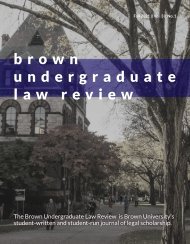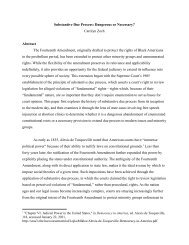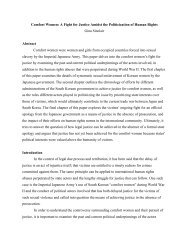Brown Undergraduate Law Review — Vol. 2 No. 2 (Spring 2021)
We are proud to present the Spring 2021 issue of the Brown Undergraduate Law Review. We hope that the works contained herein offer insight and inspiration to all who read them.
We are proud to present the Spring 2021 issue of the Brown Undergraduate Law Review. We hope that the works contained herein offer insight and inspiration to all who read them.
You also want an ePaper? Increase the reach of your titles
YUMPU automatically turns print PDFs into web optimized ePapers that Google loves.
The Legal Precedents for Police Brutality: The Enduring Legacy of the Objective Reasonableness Standard<br />
sadistically for the very purpose of causing harm. 20 Altogether, the greatest difference between the Glick test<br />
and Graham?s Fourth Amendment analysis is that, under<br />
Graham appealed to the Fourth Circuit Court of Appeals,<br />
the latter, the intent of a police officer is not relevant in<br />
which affirmed the district court?s judgment and further<br />
assessing reasonableness. The former?s criteria assess<br />
endorsed the applicability of the four-factor test to claims<br />
whether force was applied in ?good faith? or ?maliciously<br />
of unconstitutionally excessive force. The Fourth Circuit<br />
and sadistically? in its substantive due process analysis.<br />
held that since a reasonable jury applying the test could not<br />
However, this is irreconcilable with the Fourth<br />
find Connor?s use of force ?constitutionally excessive,?<br />
Amendment analysis because the ??malicious and sadistic?<br />
then the original ruling should be upheld. Graham filed a<br />
factor concerns the subjective motivations of the individual<br />
petition for certiorari, which the Supreme Court granted.<br />
officers.? 25 Moreover, ?the calculus of reasonableness?<br />
In the majority opinion authored by Chief Justice William<br />
must consider that officers are often caught in<br />
Rehnquist, the Court reversed the Fourth Circuit Court of<br />
Appeals?decision. 21 The Court found that the due process<br />
approach established by Johnson v. Glick cannot be<br />
?split-second? situations where they are forced to make<br />
decisions based on ?tense, uncertain, and rapidly evolving?<br />
circumstances.<br />
applied indiscriminately to cases of excessive force by<br />
Modern Legal Consequences of Objective<br />
police officers because there must be a constitutional basis<br />
for such claims. 22 Reasonableness<br />
The Court determined that Graham?s<br />
claim instead fell under the Fourth Amendment given that<br />
he was invoking his right to ??to be secure in [his] persons<br />
? against unreasonable ? seizures.?? 23 Using the Fourth<br />
The judicial legacy of Graham v. Connor lies in its<br />
frequent citations in lower court decisions on police<br />
brutality. The Supreme Court?s objective reasonableness<br />
Amendment, the Court determined that the standard has bound the judicial system toward favoring<br />
?reasonableness? of an officer?s actions must be assessed<br />
based on the facts and circumstances presented to the<br />
officer in the moment? disregarding analysis of intent or<br />
hindsight. In other words, one must determine whether an<br />
officer?s actions are ?objectively reasonable? based on the<br />
suspect?s threat to others, active resistance, and severity of<br />
law enforcement. To fully understand the municipal effects<br />
of the Court?s ruling, one must review additional Supreme<br />
Court and district level cases that cite Graham. Maney v.<br />
Garrison (2017) and Mullenix v. Luna (2015) are two<br />
recent cases with outcomes influenced by the 1989<br />
landmark decision.<br />
the crime committed. Therefore, the Court ruled that the<br />
To begin with, Maney v. Garrison underscores how the<br />
Fourth Circuit erred in using the Johnson v. Glick four-part<br />
notion of objective reasonableness still has a component of<br />
test because it considered intent and subjective motivations<br />
subjectivity. On May 4, 2010, Officer Terence Garrison<br />
(which play no role in Fourth Amendment analysis). Given<br />
and his police dog Bikkel tracked a robbery suspect to an<br />
this, the Court remanded the case for reconsideration.<br />
abandoned house in High Point, <strong>No</strong>rth Carolina. 26 At the<br />
20. Graham v. Charlotte, 827 F.2d 945 (1987).<br />
21. Graham v. Connor, 490 U.S. 392.<br />
22. Ibid., 490 U.S 396.<br />
23. Ibid.<br />
24. Ibid.<br />
25. Ibid.<br />
26. Maney v. Garrison, 681 Fed. Appx. 210 (2017).<br />
<strong>Brown</strong> <strong>Undergraduate</strong> <strong>Law</strong> <strong>Review</strong><br />
50










